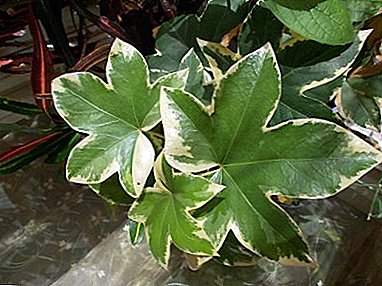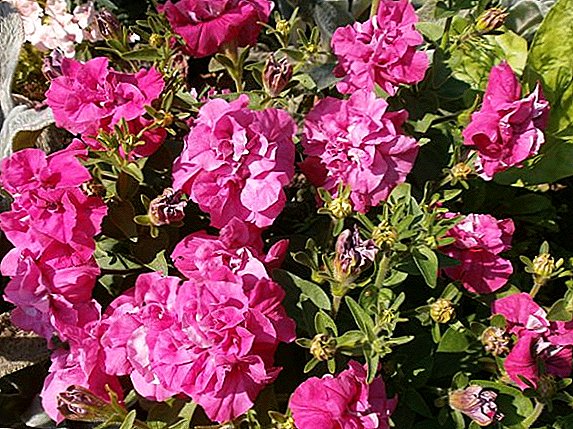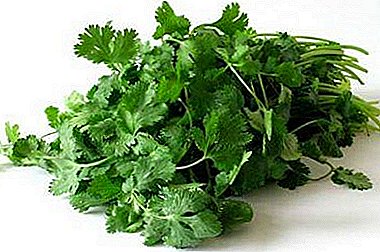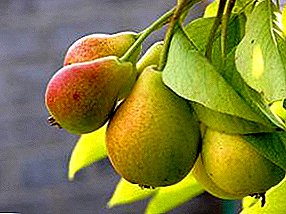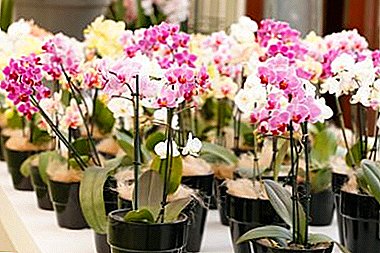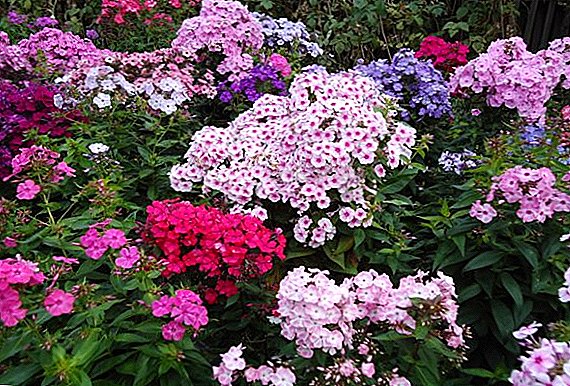 Phlox - herbaceous plant, a representative of the family Sinukhovye (Polemoniaceae). Under natural conditions, there are about 85 species, and about 40 are used in gardening.
Phlox - herbaceous plant, a representative of the family Sinukhovye (Polemoniaceae). Under natural conditions, there are about 85 species, and about 40 are used in gardening.
The stem of a plant can be straight, ascending or creeping. The height of phlox can be either very small (10-20 cm) or rather large (120-150 cm). The leaves are elongate, ovate, lanceolate.
The flowers of this plant have a strong smell and funnel shape, collected in complex inflorescences. On one inflorescence may be about 90 flowers. Color varies from white to purple, violet, crimson.
Where better to plant phlox in the garden
 When choosing a place for phlox in the garden, it is necessary to take into account the natural conditions in which they were "born." Plants are found in regions with a temperate climate, in very humid areas, where there is often no snow, and the average temperature is kept at + 4 ° C.
When choosing a place for phlox in the garden, it is necessary to take into account the natural conditions in which they were "born." Plants are found in regions with a temperate climate, in very humid areas, where there is often no snow, and the average temperature is kept at + 4 ° C.
Most often, phlox can be found in the forest, on the banks of rivers. The main thing to remember is that phloxs are very fond of humidity, so it is better to choose such areas where the groundwater will have good access to the roots.
Phlox makes both sunny places and partial shade. It is best to choose places protected by the shade of trees and tall shrubs. If there are a number of higher "neighbors" around the phlox will collect more snow, and the plant will be better protected from temperature changes, and moisture will be more intense.
Important! If you place the plant on a slope, you can avoid stagnation of water and rotting of the roots, as well as to achieve a good and uniform soil moisture.
Cultivation of phlox is best carried out on the south-west, east or southeast side. The plant should also be protected from cold winds and drafts.
The combination of phlox on a bed with other plants
 Recently, phlox in landscape design are becoming increasingly popular. They are beautiful, original and can not fail to attract the attention of gardeners. The smell of phlox is very pleasant. They look great both in single and in group plantings, especially if you plant in a single bush several seedlings of different color.
Recently, phlox in landscape design are becoming increasingly popular. They are beautiful, original and can not fail to attract the attention of gardeners. The smell of phlox is very pleasant. They look great both in single and in group plantings, especially if you plant in a single bush several seedlings of different color.
Phlox looks very beautiful in the company of both coniferous trees and exotic plants, for example, book publishing. Due to its long flowering and vitality, phloxes look very beautiful in plantings of ornamental plants.
Did you know? Yellow phloxes do not occur in nature, and red and orange colors are very conditional.Phloxes of the same color range are used to create a "bright spot" on a green lawn - such a fit looks very impressive, but to create a rhythmic fit you need to land them using the mixborder technique.
When creating compositions with phloxes, it is worth considering that in daylight plants may have slightly different shades: for example, blue may turn violet-purple. On the phlox petals of some varieties there are various blotches and stripes, which makes the plant more attractive.
Phlox care in the garden
Breeding phlox requires adhering to certain rules. You should always remember that the plant needs fertilizing, preventive pruning, as well as compliance with the rules of care for the soil around the flower.
Watering plants
 Phlox is a very moisture-loving plant, and groundwater is not always enough for it to fully moisturize. If you plant a flower too close with other plants, it will lack moisture. Therefore, in too dry weather with prolonged absence of rain, it is necessary to conduct additional watering "under the bush."
Phlox is a very moisture-loving plant, and groundwater is not always enough for it to fully moisturize. If you plant a flower too close with other plants, it will lack moisture. Therefore, in too dry weather with prolonged absence of rain, it is necessary to conduct additional watering "under the bush."
Watering should be so that the water almost did not fall on the leaves and flowers of the plant. At 1 square meter when watering you need to use 15 - 20 liters of water, it is better to water in the evening.
It should be remembered that the phlox does not tolerate stagnation of water, and therefore it is necessary to loosen the soil. If you notice that the leaves and flowers lose their appearance due to drought, you can spray the plant.
Weeding and loosening the soil
Loosening the soil is best done after watering.so that water does not stagnate and the root system "breathed". The weeds next to the bush are a breeding ground for diseases and pests.
Important! Particular attention should be paid to low-growing varieties, the stems of which are very thin and can easily tear, and the weeds around them contribute to this.
Loosening should be carried out starting from the end of March and ending before the bush goes into hibernation.
Fertilizing flowers
Despite the fact that the growth of phlox can be divided into 3 stages, you need more fertilizing.
3 stages of flower development:
- Stage 1 - the most active in development, at this time it is necessary to give Phlox a lot of nitrogen and actively moisten the flower;
- Stage 2 - flowering and budding, at this time more potassium and phosphorus are needed, and the amount of nitrogen should be reduced;
- Stage 3 - The most difficult period, as it is now formed seeds, and the plant absorbs all sorts of top dressing, preparing for bed.

The first feeding of phlox is carried out immediately after the snow melts. Usually at this time use complex fertilizer in granules. At the same time, loosening (for better penetration of fertilizers) and mulching (for the steam effect) should be carried out. It is especially important to mulch plants aged 3-4 years.
The second time fertilizer is applied in early July - late May. You can use a mullein infusion (prepare yourself or buy ready-made) with the addition of ash.
Top dressing will be more effective if you add nitroammophos or “Kemira Universal” to it (ratio: half tablespoon to a bucket of water). If these materials are not at hand, they can be replaced by any complex mineral fertilizer that you need to use according to the instructions.
The plants are fed for the third time depending on the variety: the earlier varieties are fed in the middle of June, and the later ones must be fertilized at the end of June. During this period, increase the composition of potassium in the feed. Enhance the effect with the help of a solution of urea, which contribute foliar way.
The next time fertilizers are applied in early July. You can use the same fertilizer as for the June feeding, but you need to add a little superphosphate (10 - 15 g).
 The following fertilizing is carried out after flowering - complex fertilizers will be your best assistant during this period. You can also water the plant with a solution of ash.
The following fertilizing is carried out after flowering - complex fertilizers will be your best assistant during this period. You can also water the plant with a solution of ash.
There are several rules that will make feeding more effective:
- feeding is best done in the evening;
- if you use a dry dressing - rely on the weather forecast and spend it before the rain;
- the amount of fertilizer should not be excessive.
Pruning phlox
Most gardeners recommend pruning phlox in the fall, before the hive takes over for the winter. You need to start immediately after the bush has blossomed. A month is allocated for this procedure: from the end of September to the end of October.
It is at this time that all the beneficial substances that the plant accumulates throughout the entire period of active growth pass into the root. This period may vary in different zones.
Did you know? Regardless of the region, pruning needs to be completed before regular frosts.
Despite the opinion of most gardeners that pruning should be done in the fall, some tend to think that spring pruning has a right to exist. Such pruning is recommended to be carried out only in those areas where there is little snow in winter, arguing that the stems will be useful for the plant for the winter to keep the snow on itself.
 Pruning can be done in two ways:
Pruning can be done in two ways:
- to ground level to get rid of possible pests and phlox diseases;
- 10 cm above the ground for snow to cover the plant.
Preparation of phlox bushes for winter
Phloxes, like any perennial, tend to reject the weakest shoots in winter. In order for your plant not to suffer large losses, it is necessary to prepare the bush for winter sleep in several stages:
- Autumn fertilization of phlox with fertilizers containing a greater amount of potassium phosphate substances.
- Pruning phlox, which is carried out with the aim of rejuvenating the bush and disease prevention.
- Autumn mulching of phlox. This procedure is carried out using horse manure (make 3 buckets immediately after the fall feeding). On the mulch soil, you can put additional coverage that will delay the snow and prevent the soil from freezing. For this procedure it is better to use only organic products.
Phlox propagation
Planting phlox in the spring in the ground can be carried out in several ways. Among them are vegetative and seed methods.
 Before discussing methods of reproduction, you should remember about phlox transplantation. Very often there is a question on the forums: how often should phlox be transplanted? You can repot as much as you see fit, adhering to certain rules.
Before discussing methods of reproduction, you should remember about phlox transplantation. Very often there is a question on the forums: how often should phlox be transplanted? You can repot as much as you see fit, adhering to certain rules.
This is best done from late August to mid-September. That's when the plant has the opportunity to take root. Planting and transplant procedures are very similar, and the soil for phloxes can be used the same.
Dividing bush
The most popular way of phlox breeding - bush dividing. They usually carry out the procedure in the spring (after the retreating frosts) or in the early autumn so that the roots start well.
Only large bushes can be divided. The bush that you are going to divide, you must carefully dig up, trying not to damage the rhizome, shake off the root neck and the bush itself from the ground.
 The roots should be carefully unraveled and separated from each other so that each division has the seedlings of shoots, young buds and some roots. A divided bush should be planted immediately so that the roots do not dry out. If the planting needs to be transferred, the root can be moistened in a clay mash.
The roots should be carefully unraveled and separated from each other so that each division has the seedlings of shoots, young buds and some roots. A divided bush should be planted immediately so that the roots do not dry out. If the planting needs to be transferred, the root can be moistened in a clay mash.
Important! If you need to divide and plant a bush in the summer, then it should be done on a cloudy day or in the evening.The divided bush will start well and grow, and next year it will also be possible to propagate it, dividing.
Cuttings
The cutting method is best suited for beginner gardeners. For grafting choose healthy adult plants.
The cuttings are cut in such a way that there are 2 buds (node) on one branch: one cut is made directly under the knot, the other - 2-3 cm above the knot. We remove the leaves from the cutting: the lower ones are cut off completely, and the upper ones - to half. Cuttings can immediately be planted in the ground at a permanent place, or in boxes for seedlings.
If you are using a box, then you should sprinkle the planted material with Vermiculite (thin layer) on top, and if the plants grow immediately on the bed, use humus, and then Vermiculite (also peat will do).
Boxes put in a warm place, and shelter the beds. Young cuttings should be protected from direct sunlight and watered 1 time in 3 days for 3 weeks. The result can be seen in 2-3 weeks.
 If you used a box, then after the first shoots appear, the cuttings are transplanted into a special bed for growing, and here they can grow until the next spring. If you immediately used the open ground, you can promulcate the bed for the winter with humus, fallen leaves or peat.
If you used a box, then after the first shoots appear, the cuttings are transplanted into a special bed for growing, and here they can grow until the next spring. If you immediately used the open ground, you can promulcate the bed for the winter with humus, fallen leaves or peat.
Did you know? If you decide to conduct cuttings in the summer or autumn, then only the upper part of the shoot can be used as planting material.
Layering
Reproduction by layering - one of the easiest procedures in the cultivation of phlox on your site.
The flower should be plentifully poured with earth to about half the height of the bush. On the stems, over time, the layers begin to appear, which actively germinate. When the root system of the cuttings will be sufficiently developed, and the cuttings will grow by 10-15 cm, they must be carefully freed from the soil and landed in a permanent place.
Seeds
If you decide to plant a seed, remember that some properties may be lost. Sowing seeds is best for the winter: during the wintering period, a natural stratification will take place.
 Clear the seeds from the bolls immediately before sowing, should be selected seeds of round shape, the darkest in color. The first shoots appear in April, they need to be transplanted only when they grow to a height of 8-10 cm. Seedlings are planted at a distance of 12-15 cm from each other, so that the development takes place actively.
Clear the seeds from the bolls immediately before sowing, should be selected seeds of round shape, the darkest in color. The first shoots appear in April, they need to be transplanted only when they grow to a height of 8-10 cm. Seedlings are planted at a distance of 12-15 cm from each other, so that the development takes place actively.
If you follow all the rules and recommendations for the care of phlox, you will definitely be able to decorate your site with these beautiful, bright colors.


